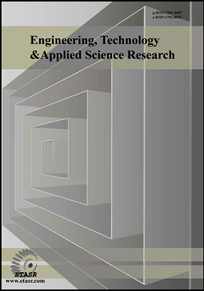The Mechanical Properties of Ferrocement Mortar with Waste Plastic Fibers at Elevated Temperatures
Received: 21 July 2022 | Revised: 31 July 2022 | Accepted: 10 August 2022 | Online: 2 October 2022
Corresponding author: F. A. Al-Fahdawi
Abstract
The main aim of the current research was to investigate the behavior of ferrocement mortar reinforced with waste plastic fibers at elevated temperatures. The use of PET residues in ferrocement mortar at normal temperatures could be a viable option. However, the utilization of PET-containing ferrocement mortar in high-temperature applications requires more research. In this study, one reference mix was made along with 3 other mixes containing Polyethylene Terephthalate (PET) fiber by volumetric ratios of 0.5, 0.75, and 1%. Compressive and flexural strength tests were performed on the samples before and after being exposed to elevated temperatures. Each batch of ferrocement mortar samples was heated to the requisite temperature for roughly 60 minutes, then was progressively cooled to room temperature before being tested. The compressive and flexural strengths of some samples were evaluated at room temperature (25°C). Other samples were evaluated after being exposed to high temperatures in an electric furnace (100°C, 200°C, 400°C, and 600°C). Both compressive and flexural strengths were found to be significantly reduced after being exposed to a temperature greater than 400°C. Results proved that the addition of 0.75% PET was determined as the optimum percentage that enhanced the mechanical properties of the produced ferrocement mortar at 25°C. At 200°C, the ferrocement mortar samples retained their original color. As a result of the combustion of PET fibers, black spots formed on the top surfaces of the tested specimens that were heated to 400°C.
Keywords:
elevated temperature, ferrocement mortar, flexural strength, compressive strength, PET, mechanical propertiesDownloads
References
L. M. Jiang, F. H. Tang, and M. L. Ou, "Experimental Research on the Strengthening of RC Columns by High Performance Ferrocement Laminates," Advanced Materials Research, vol. 243–249, pp. 1409–1415, 2011. DOI: https://doi.org/10.4028/www.scientific.net/AMR.243-249.1409
N. A. Memon, A. H. Larik, M. A. Bhutto, N. A. Lakho, M. A. Memon, and A. N. Memon, "Effect of Prepackaged Polymer on Compressive, Tensile and Flexural Strength of Mortar," Engineering, Technology & Applied Science Research, vol. 8, no. 3, pp. 3044–3047, Jun. 2018. DOI: https://doi.org/10.48084/etasr.2039
P. Ellis, "The Analysis of Mortar: The Past 20 Years," Building Conservation. https://www.buildingconservation.com/articles/mortar/
mortar.htm.
O. M. Okeyinka and O. J. Idowu, "Assessment of the Suitability of Paper Waste as an Engineering Material," Engineering, Technology & Applied Science Research, vol. 4, no. 6, pp. 724–727, Dec. 2014. DOI: https://doi.org/10.48084/etasr.485
S. Zhang and B. Zhao, "Influence of polypropylene fibre on the mechanical performance and durability of concrete materials," European Journal of Environmental and Civil Engineering, vol. 16, no. 10, pp. 1269–1277, Nov. 2012. DOI: https://doi.org/10.1080/19648189.2012.709681
C. Marthong and D. K. Sarma, "Influence of PET fiber geometry on the mechanical properties of concrete: an experimental investigation," European Journal of Environmental and Civil Engineering, vol. 20, no. 7, pp. 771–784, Aug. 2016. DOI: https://doi.org/10.1080/19648189.2015.1072112
S. P. Shah, High Performance Concrete: Properties and Applications. New York, NY, USA: McGraw-Hill, 1994.
R. Feasey and A. Buchanan, "Post-flashover fires for structural design," Fire Safety Journal, vol. 37, no. 1, pp. 83–105, Feb. 2002. DOI: https://doi.org/10.1016/S0379-7112(01)00026-1
S. Nasir, B. I. Al-Hadithi, and A. I. Al-Hadithi, "The Effects of Adding Waste Pet Fibers on the Some Mechanical Properties of Cement Mortar under Exposure to Elevated Temperature," Journal of Engineering and Applied Sciences, vol. 13, no. 11, pp. 3985–3996, 2018.
A. Saand, T. Ali, M. A. Keerio, and D. K. Bangwar, "Experimental Study on the Use of Rice Husk Ash as Partial Cement Replacement in Aerated Concrete," Engineering, Technology & Applied Science Research, vol. 9, no. 4, pp. 4534–4537, Aug. 2019. DOI: https://doi.org/10.48084/etasr.2903
Iraqi Specification No. 45 - Aggregates from natural sources for concrete and construction. Baghdad, Iraq, 1984.
EN 12390-3:2019 - Testing hardened concrete - Part 3: Compressive strength of test specimens. CEN, 2019.
Standard Test Method for Flexural Strength of Concrete (Using Simple Beam With Center-Point Loading). ASTM International, 2015.
A. S. M. A. Awal and I. A. Shehu, "Performance evaluation of concrete containing high volume palm oil fuel ash exposed to elevated temperature," Construction and Building Materials, vol. 76, pp. 214–220, Feb. 2015. DOI: https://doi.org/10.1016/j.conbuildmat.2014.12.001
A. I. Al-Hadithi, A. T. A.- Ejbari, and G. S. Jameel, "Behaviour of Waste Plastic Fiber Concrete Slabs Under Low Velocity Impact," Iraqi Journal of Civil Engineering, vol. 9, no. 1, pp. 135–148, 2013. DOI: https://doi.org/10.37650/ijce.2013.80395
A. A. Chyad, "Flexural Strength and Impact Behavior of Ferrocement Members Containing Waste Materials," M.S. thesis, University of Anbar, Ramadi, Iraq, 2021.
Downloads
How to Cite
License
Copyright (c) 2022 F. A. Al-Fahdawi, A. I. Al-Hadithi, J. A. Al-Asafi

This work is licensed under a Creative Commons Attribution 4.0 International License.
Authors who publish with this journal agree to the following terms:
- Authors retain the copyright and grant the journal the right of first publication with the work simultaneously licensed under a Creative Commons Attribution License that allows others to share the work with an acknowledgement of the work's authorship and initial publication in this journal.
- Authors are able to enter into separate, additional contractual arrangements for the non-exclusive distribution of the journal's published version of the work (e.g., post it to an institutional repository or publish it in a book), with an acknowledgement of its initial publication in this journal.
- Authors are permitted and encouraged to post their work online (e.g., in institutional repositories or on their website) after its publication in ETASR with an acknowledgement of its initial publication in this journal.





